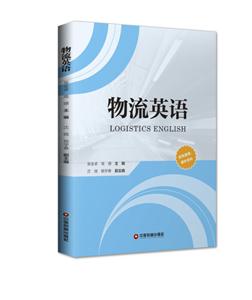-
>
西班牙语词根宝典
-
>
英语大书虫世界经典名译典藏书系:中国人的精神 (英汉对照)(精选权威版本)
-
>
许渊冲译唐诗三百首:汉文·英语
-
>
四级词汇词根+联想记忆法:乱序版
-
>
The secret garden
-
>
英国文学名篇选注
-
>
许渊冲译千家诗
物流英语 版权信息
- ISBN:9787504764959
- 条形码:9787504764959 ; 978-7-5047-6495-9
- 装帧:平装-胶订
- 册数:暂无
- 重量:暂无
- 所属分类:>>
物流英语 本书特色
《物流英语》紧密结合物流业发展的新形势和新特点,系统介绍了物流导论、物流系统(运输、仓储、库存、包装、装卸搬运、配送、信息技术)、整合物流管理(物流成本管理、物流质量管理、物流服务管理)、供应链管理、商业合同与文档、国际物流、物流发展新形势等专业基础知识,并通过强化培训,培养和提高读者的实际操作和应用能力。《物流英语》每一章都包括正文、词汇与表达,并配有相应的课后习题供学生复习和理解。另外,根据正文内容的不同,还设置了英语情景对话、案例分析、单证制作等学习内容,有利于师生在课堂上的互动,帮助学生提高学习兴趣、增强学习效果。《物流英语》可以作为物流工程与物流管理专业和其他相关专业的教学用书,也可供物流研究者及社会从业者阅读参考。
《物流英语》选材广泛,以国内外近期出版的教材、期刊和网站资料以及世界知名物流公司的相关资料为基础,时效性强、内容丰富、材料翔实,具有很强的理论性和实用性。
物流英语 内容简介
本书紧密结合物流产业发展的特点, 全面系统地介绍了物流英语的相关知识。全书共有七章, 内容涵盖物流导论、物流系统 (运输、仓储、库存、包装、装卸搬运、配送、信息技术) 、整合物流管理 (物流成本管理、物流质量管理、物流服务管理) 、供应链管理、商业合同与文档、国际物流和物流发展新趋势七大部分。
物流英语 目录
1.1 Fundamentals
1.1.1 Definition of Logistics
1.1.2 Historical Development of Logistics
1.1.3 Logistics Related Activities
1.1.4 Objectives of Logistics
1.1.5 7R Theory of Logistics
1.2 The Role of Logistics in the Economy and Organizations
1.2.1 Logistics in the Economy- A Macro Perspective
1.2.2 Logistics in the Firm - A Micro Perspective
1.3 Logistics Industry in China
1.3.1 Current Status of the Logistics Industry in China
1.3.2 Types of Logistics Enterprises in China
1.3.3 Logistics Prosperity Index
Exercises
Chapter 2 Logistics Systems
2.1 Transportation
2.1.1 Introduction to Transportation
2.1.2 Modes of Transport
2.1.3 Intermodal Transportation
2.1.4 Containerization
2.2 Warehousing
2.2.1 Introduction to Warehouses
2.2.2 Introduction to Warehousing
2.2.3 Warehousing Operations
2.3 Inventory
2.3.1 Introduction to Inventory
2.3.2 Types of Inventory
2.3.3 Inventory Management
2.4 Packaging
2.4.1 Introduction to Packaging
2.4.2 Common Packaging Materials and Determinants
2.4.3 Packaging Marks
2.5 Handling
2.5.1 Introduction to Handling
2.5.2 Operation Machinery
2.5.3 Material Flow Management
2.6 Distribution
2.6.1 Distribution Channels
2.6.2 Distribution Centers
2.6.3 Distribution Activities
2.7 Information Technology
2.7.1 Information Technology in a Supply Chain
2.7.2 Order Management and Customer Service through Information System
Exercises
Chapter 3 Integrated Logistics Management
3.1 Logistics Cost Management
3.1.1 Introduction
3.1.2 Methods of Logistics Cost Management
3.1.3 Case Study
3.2 Logistics Quality Management
3.2.1 Introduction
3.2.2 Logistics Quality Management Approach
3.2.3 Case Study
3.3 Logistics Service Management
3.3.1 Introduction
3.3.2 Logistics Service Quality Evaluation
3.3.3 Case Study
Exercises
Chapter 4 Supply Chain Management
4.1 Introduction to Supply Chain
4.1.1 What Is A Supply Chain
4.1.2 Decision Phases of A Supply Chain
4.1.3 Process View of A Supply Chain
4.2 Supply Chain Management Methods
4.2.1 Quick Response (QR)
4.2.2 Efficient Consumer Response (ECR)
4.2.3 Activity Based Classification (ABC)
4.2.4 Value Chain Analysis (VCA)
4.3 Supply Chain Drivers and Obstacles
4.3.1 Drivers of Supply Chain Performance
4.3.2 Obstacles to Achieving Strategic Fit
4.3.3 Case Study: Mintendo Game Girl
Exercises
Chapter 5 Business Contracts and Documents
5.1 Business Negotiation
5.1.1 Elemental Procedures of Negotiation
5.1.2 Strategies of Business Negotiation
5.1.3 Basic Principles of Negotiation
5.1.4 Business Letters: Enquiry and Quotation/Offer
5.2 Contract
5.2.1 Introduction to Business Contract
5.2.2 Formation of A Business Contract
5.2.3 Sample Contract Document
5.3 Payment
5.3.1 Payment Instruments
5.3.2 Remittance and Collection
5.3.3 Letter of Credit
Exercises
Chapter6 International Logistics
6.1 Introduction to International Logistics
6.1.1 Definition of International Logistics
6.1.2 Features of International Logistics
6.1.3 The Role of Governments in International Logistics
6.2 International Trade Terminology
6.2.1 WhatAre the Incoterms 2010
6.2.2 Case Study
6.3 International Cargo Transportation
6.3.1 Ocean Transportation
6.3.2 Air Transportation
6.3.3 Railway Transportation
6.3.4 Road Transportation
6.3.5 Multimodal Transportation
6.4 International Cargo Insurance
6.4.1 Maritime Loss
6.4.2 Kinds of Cargo Insurance
6.4.3 Insurance Premium
6.4.4 Insurance Claim
6.4.5 Insurance Policy Document
6.5 International Cargo Warehousing
6.5.1 The Role of International Warehousing
6.5.2 Bonded Warehouse
6.5.3 Bonded Zones and Bonded Warehouses in China
6.6 Customs and Customs Clearance
6.6.1 Introduction
6.6.2 Customs Declaration
6.6.3 Customs Clearance Process for Bonded Goods
6.6.4 Import/Export Duty
6.6.5 Filling in a Declaration Form
6.7 International Cargo Inspection
6.7.1 What Is Inspection
6.7.2 Inspection Time and Places
6.7.3 Inspection Standards
6.7.4 Inspection Institutions
6.7.5 Inspection Certificates
6.8 International Logistics Services
6.8.1 International Freight Forwarding
6.8.2 International Shipping Agency
6.8.3 International Express
Exercises
Chapter 7 New Trends of Logistics
7.1 Green Logistics
7.1.1 Introduction to Green Logistics
7.1.2 Environmental Issues in Logistics
7.1.3 Development and Application of Green Logistics
7.1.4 The Plan for Green Logistics
7.1.5 How to Implement Green Logistics in A Greener Supply Chain
7.2 Third-Party Logistics(3PL)
7.2.1 Introduction to 3PL
7.2.2 3PL Providers
7.2.3 Future Trend of 3PL Industry
7.3 Reverse Logistics
7.3.1 Introduction to Reverse Logistics
7.3.2 The Reverse Logistics Motivators
7.3.3 Reverse Logistics Opportunities and Challenges
Exercises
References
物流英语 节选
Since there are some differences among the definitions, to avoid potential misunderstanding of the meaning of logistics, this book adopts the authoritative definition provided by the Council of Supply Chain Management Professionals(CSCMP, formerly known as Council of Logistics Management), the preeminent worldwide professional association dedicated to the advancement and dissemination of research and knowledge on supply chain management. The definition is as follows: “Logistics is the process of planning, implementing, and controlling the efficient, effective flow and storage of goods, services, and related information from point of origin to point of consumption for the purpose of conforming to customer requirements.” Note that this definition includes inbound, outbound, internal, and external movements, and return of materials for environmental purposes. —Council of Supply Chain Management Professionals
物流英语 作者简介
吴金卓,毕业于美国西弗吉尼亚大学,现为东北林业大学物流工程专业硕士生导师。先后主持国家科技支撑计划专题、国家自然科学基金项目,发表SCI、EI检索学术论文20余篇,发表中文核心论文8篇,发表教改论文2篇。
- >
中国人在乌苏里边疆区:历史与人类学概述
中国人在乌苏里边疆区:历史与人类学概述
¥25.0¥48.0 - >
苦雨斋序跋文-周作人自编集
苦雨斋序跋文-周作人自编集
¥6.9¥16.0 - >
人文阅读与收藏·良友文学丛书:一天的工作
人文阅读与收藏·良友文学丛书:一天的工作
¥16.5¥45.8 - >
伊索寓言-世界文学名著典藏-全译本
伊索寓言-世界文学名著典藏-全译本
¥9.3¥19.0 - >
罗曼·罗兰读书随笔-精装
罗曼·罗兰读书随笔-精装
¥17.4¥58.0 - >
随园食单
随园食单
¥15.4¥48.0 - >
巴金-再思录
巴金-再思录
¥14.7¥46.0 - >
月亮与六便士
月亮与六便士
¥18.1¥42.0
-
4.23文创礼盒A款--“作家言我精神状态”
¥42.3¥206 -
4.23文创礼盒B款--“作家言我精神状态”
¥42.3¥206 -
一句顶一万句 (印签版)
¥40.4¥68 -
百年书评史散论
¥14.9¥38 -
1980年代:小说六记
¥52.8¥69 -
中图网经典初版本封面-“老人与海”冰箱贴
¥20¥40



















